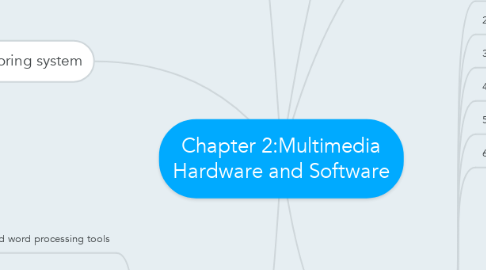
1. 4 basic stages
1.1. 1. Planning and costing
1.1.1. Define the objectives and scope
1.1.2. Target user
1.1.3. Set the content
1.2. 2. Designing and Producing
1.2.1. Perform the task of finish product
1.3. 3. Testing
1.3.1. Two phases of testing :
1.3.2. Alpha Testing
1.3.2.1. Often performed only by user within the organization developing.
1.3.2.2. Main interest : concept, format, user interface and the layout.
1.3.3. Beta Testing
1.3.3.1. Main interest : find bug or content errors.
1.3.3.2. The testing group should be represent by the real user.
1.4. 4.Delivering
1.4.1. Final stage
1.4.2. Package and deliver the project to the end user.
1.4.3. Follow up over time with tweaks, repairs and upgrade.
2. Software
2.1. Text editing and word processing tools
2.1.1. Word processors such as Microsoft word and WordPerfect
2.2. OCR software
2.2.1. convert bitmapped character into electronically recognizable text
2.3. Painting tools allow you to create and modify bitmap images
2.3.1. Photoshop,Fireworks, and Painter are example
2.4. Drawing tools allow you to create and modify vector graphics.
2.4.1. To reduce download time and scaling problem with web graphics
2.5. 3-D modeling tools allow rendering of objects in a three-dimensional perspective,
2.5.1. take long time to render,plan accordingly
2.6. Image editing tools
2.6.1. enhancing retouching,blurring,sharpening,lightening existing bitmapped images.
2.6.2. support third party plug-in
2.7. Sound editing tools
2.7.1. cut,copy,paste,and edit certain segments of the music.
2.8. Animation,video,and digital movie tools.
3. Authoring system
3.1. An authoring tool is a software package which allow developers to organize and edit,design, create interactivity.
3.2. Types of authoring tools
3.2.1. card and page based
3.2.1.1. arrange like pages of a book or cards in a stack
3.2.2. icon and object based
3.2.2.1. provide a visual programming approach to organizing and presenting multimedia application.
3.2.3. time based
3.3. Objects
3.3.1. generally treat multimedia element as objects
3.4. Authoring tool
3.4.1. editing and organizing reatures
3.4.2. programming features
3.4.3. Interactivity features
3.4.4. performance tuning and playback features
3.4.5. delivery ,cross platform,and internet playability features .
4. The Intangible
4.1. Creative
4.2. Organization
4.3. Communication
5. Multimedia Skills
5.1. 1. Project manager
5.2. 2. Multimedia Designer
5.3. 3. Interface Designer
5.4. 4. Writer
5.5. 5. Audio/Video Specialist
5.6. 6. Multimedia Programmer
6. Hardware
6.1. 1. Production platforms
6.2. 2. Windows vs Macintosh
6.3. 3. Connection
6.4. 4. IDE
6.5. 5. USB (Universal Serial Bus)
6.6. 6. FireWire
6.7. Memory and storage devices
6.7.1. 1. RAM (Random Access Memory)
6.7.2. 2. ROM (Read Only Memory)
6.7.3. 3. Hard Disks
6.7.4. 4. Flash or thumb drives
6.7.5. 5. CD-ROM
6.7.6. 6. DVD
6.7.7. 7. Blu-ray discs
6.8. Input devices
6.8.1. Optical character recognition (OCR) used to convert printed matter into ASCII text files
6.8.2. Microphones
6.8.3. Digital cameras
6.9. Output devises
6.9.1. 1. Stereo
6.9.2. 2. Monitor
6.9.3. 3. Projector
6.9.4. 4. Printer

